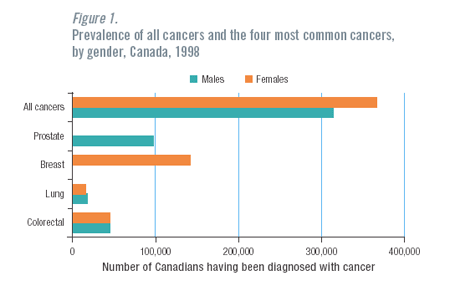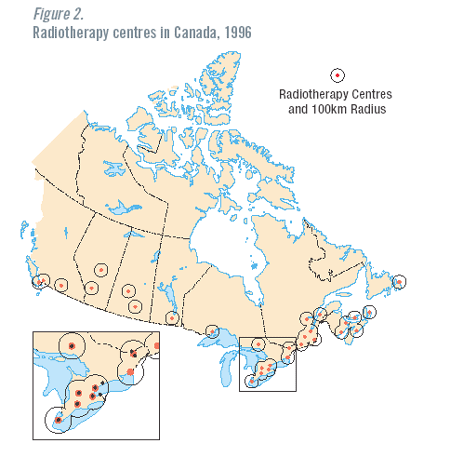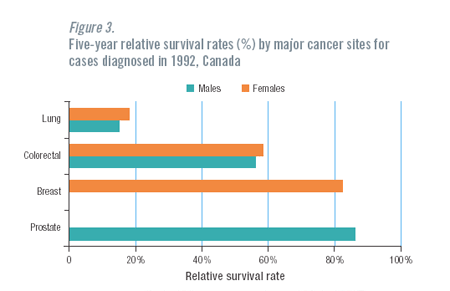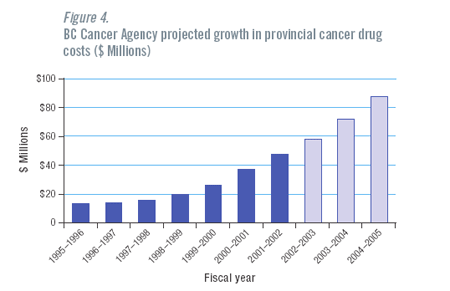Common menu bar links
Institutional links
Diseases & Conditions
Health & Safety
Research & Statistics
Agency Information
Search Box
E-mail this page
Progress Report on Cancer Control in Canada
[Previous] [Table of Contents] [Next]
Cancer Treatment
Cancer treatment and outcomes are improving as a result of a better understanding of cancer at the cellular and molecular level and the adoption of therapies proven to be of benefit through clinical trials.
The most striking contributions from treatment over the last two decades have come from: i) the use of chemotherapy in advanced testicular cancer, ovarian cancer, leukemias and lymphomas, and as a therapy after surgery for breast and colon cancer; ii) the application of high-precision radiotherapy for prostate, head and neck cancer, and other tumour sites; and iii) the greater use of organ-preserving surgical approaches for breast, rectal and laryngeal cancers and for sarcomas of the extremities. In addition, greater focus on supportive care and the introduction of highly effective anti-nausea medications and long-acting analgesics have helped to improve the quality of life of the cancer patient.
Who provides cancer treatment?
Most provinces have publicly funded agencies that are responsible for managing treatment facilities. Systemic therapy (the administration of chemotherapy drugs, hormones, antibodies vaccines and other agents that can travel through the body to attack cancer) is provided through cancer centres and treatment facilities outside of the comprehensive cancer centres (e.g. special outreach clinics, or medical oncologists in private practice). Radiotherapy is provided in cancer centres. Surgery (including biopsies) is required to establish the diagnosis in almost all cancers and is the primary form of therapy in over half of all cancers. It is provided through publicly funded acute care hospitals. Supportive care services are provided through a patchwork of hospital, cancer centre and community-based services. Roughly one-half of all cancer patients receive treatment in a cancer centre at some point of their treatment.
The provision of cancer treatment is a provincial and territorial responsibility. A majority of provinces have provincial cancer agencies that are responsible for many aspects of treatment; however, even in these provinces, a considerable proportion of cancer treatment occurs in community hospitals that are independent of the agencies. The federal government helps fund health care under the Canada Health and Social Transfer (CHST), and provides primary care for First Nations and Inuit.
Optimal care is best provided by multidisciplinary teams, which may consist of surgeons, radiation oncologists and medical oncologists, working collaboratively with a variety of other health care professionals, including nurses, anaesthesiologists, medical physicists, radiation therapists, pathologists, pharmacists, primary care physicians and supportive care workers. Health Canada has established the Primary Health Care Transition Fund (PHCTF) to support evidencebased innovation related to home care, pharmacare and primary care in an effort to move toward a more integrated health system.
How is cancer treated?
The first step in the treatment of cancer is diagnosis. Solid tumours are usually diagnosed by taking a tissue biopsy and then examining the tissue under a microscope. After a cancer is diagnosed, it is staged. The stage of a cancer depends on its size and the extent to which it has spread to other parts of the body. The stage of a cancer helps to determine how it will be treated. A treatment plan is developed. Clinical practice guidelines have been developed for many cancers to help ensure the adoption of therapies proven to be of benefit through experimental (clinical) trials. The three main forms of cancer therapy are systemic therapy, radiation, and surgery. A successful cancer treatment system should improve survival. It should also strive to improve the quality of life of the cancer patient by offering appropriate supportive care, minimizing waiting times and maximizing access to nearby treatment, and be cost-effective.
Childhood cancer treatment
In contrast to adult cancers, most childhood cancers are treated with chemotherapy and radiotherapy. Childhood cancer is best managed in specialist institutions devoted to the care of sick children. In most provinces, pediatric oncologists working in special units of children’s hospitals provide these services. The treatment of childhood cancer has been increasingly successful; for most childhood cancers a cure can be anticipated. With improved survival, the treatment of childhood cancer has moved from a focus on saving the life of a child to minimizing the long-term effects of treatment among survivors. Skilled management and the availability of rehabilitation services are crucial to this process.
Cancer staging
Cancer staging is an essential component of cancer control as it provides information to guide health care professionals in treating cancer appropriately. Knowledge of cancer staging also improves communication between health care professionals and patients, allowing patients to better understand the diagnosis, optimal therapy and prognosis. The use of cancer staging data is important to a variety of other stakeholders, including researchers, decisionmakers, policy-makers and administrators. Some specific uses of staging data include evaluation of the effectiveness of screening and treatment programs, analyses of cancer prevalence and survival, research into new treatments, and resource planning for health care management.
Currently, collection of staging data within provinces is incomplete and there is no national database of stage information. However, in spite of the complexity of the task, efforts toward establishing a cancer stage database are underway and are focused on the development of standards, policy, educational tools and the infrastructure necessary to support data collection.
Determining appropriate treatment
The most appropriate therapy for each stage and type of cancer is defined through the systematic study of treatment strategies in clinical trials. The need for clinical trials of new therapies has become greater as many new, potentially effective strategies are emerging from basic laboratory research. Unfortunately, only about 5% of adult Canadians with cancer participate in clinical trials during the course of their illness. This is in contrast to pediatric cancer, in which the vast majority of children are treated as part of clinical research protocols. The high level of participation in clinical trials by pediatric patients is attributable, in part, to the fact that tumours in children have been more responsive to treatment, leading to greater successes. In contrast, most adult cancers have proven relatively resistant to treatment. Also, the greater number of adult patients tends to overwhelm treatment facilities, which leads to a lower priority being given to clinical research.
Clinical practice guidelines
The proliferation of new and effective treatments has created more options for patients and physicians. The large volume of new and sometimes conflicting information on best practices has placed greater emphasis on systematic reviews of the research evidence and the collation and formatting of this evidence into clinical practice guidelines. Clinical practice guidelines are evidence-based documents that assist patients and health care providers in making the most appropriate decisions about an individual patient’s care. Several provinces have invested in clinical practice guideline development. In addition, mechanisms are in place to share guideline development through the Interprovincial Drug Strategies and Guidelines Group Internet site and to make completed guidelines available through provincial cancer agency Internet Web sites. Breast cancer guidelines on a number of different topics have been developed through the Canadian Breast Cancer Initiative. The Canadian Strategy for Cancer Control places a high priority on the development of national guidelines for cancer care. At present, there is no mechanism to routinely monitor the consistency of clinical practice with respect to guideline recommendations, although enhancements to provincial information systems may soon enable such studies to be conducted.
Increasing demand for diagnostic treatment and services
The increase in the numbers of patients with newly diagnosed cancer is creating a larger demand for diagnostic and treatment services. Because treatments are improving and benefiting more people with cancer, more individuals are being treated for longer periods of time, resulting in more patients living with cancer (more prevalent cases). In 1998, it was estimated that there were 680,000 individuals (313,000 males, 367,000 females) either living with cancer or survivors of cancer in Canada. The prevalence of all cancers and of the four main cancers is shown in Figure 1. The number of prevalent cases of cancer is estimated to be increasing by 6% to 8% per year and is contributing to the growing burden of cancer care. By 2020, it is projected that the number of cancer patients requiring treatment in Canada will have doubled from the 2001 levels.

Access
All provinces have dedicated cancer treatment centres for the provision of radiotherapy services. There are 37 radiotherapy centres distributed across the ten provinces; and 75% of the population reside within 100 kilometres of one of these centres (Figure 2). Proximity to a radiotherapy treatment centre helps to ensure access to appropriate care for curative and palliative treatments.

Treatment waiting times
Professional associations of cancer specialists in Canada, such as the Canadian Association of Radiation Oncologists and the Canadian Association of Medical Oncologists, have generally recommended that the time a patient waits from referral date to consultation and from the decision to treat to actual treatment should be two weeks or less. Comprehensive, high-quality data on cancer waiting times, or of their effects on survival, do not exist in Canada. However, over recent years, excessive waiting times for radiotherapy have required some provinces to send patients to other provinces or out of the country for treatment.
Excessive waiting is attributable to increased incidence and prevalence of cancer, insufficient facilities (operating rooms, radiotherapy equipment), human resource shortages, inefficient health care delivery systems, increased screening, new clinical care indications, or combinations of these factors. Many programs have been unprepared for the impact of changes in therapy (lumpectomy substituting for mastectomy in the treatment of breast cancer, increasing demands for radiotherapy) or the impact of screening programs, let alone the increase in patient numbers as Canada’s population ages. In addition, there are well-documented shortages of many cancer care providers across Canada. The Canadian Association of Provincial Cancer Agencies has identified significant numbers of vacant positions in radiation and medical oncology, medical physics and radiation therapy.
In recent years, provinces have invested in new cancer treatment facilities and equipment to address the growth in caseload. Enhanced efficiency in the cancer system will be achieved with greater integration of services and the implementation of better information systems that can access clinical information on patients on a regional basis.
Treatment outcomes
Declining mortality rates
Improvements in treatment, if generally applied, should translate into reduced mortality from the relevant cancer at the population level, as will effective prevention and screening activities. The relative contribution of different cancer control interventions to the observed decline in mortality rates is difficult, if not impossible, to determine. Nevertheless, treatment is no doubt contributing to the decline in overall mortality rates.
Relative survival rates
Improvements in outcome after treatment are generally measured in terms of five-year relative survival. Survival rates for the four common cancers relative to rates expected in the general population are available. The five-year relative survival rates were highest for prostate cancer, followed by breast cancer, colorectal cancer and lung cancer (Figure 3). Relative survival rates vary by age group for some cancers and by province. The reasons for the variance in the relative survival rates of cancers are numerous. They include: the extent to which screening programs are implemented and the use of early detection methods; differences in how aggressively cancers behave; the ability to give treatments to different age groups; the ease of access to treatment; and variations in cancer registry reporting. Although treatment undoubtedly contributes to five-year relative survival, the information on trends over time and the lack of stage-specific data make it difficult to comment on the precise contribution of treatment to the improvements in survival observed. However, with respect to the recent decline in breast cancer mortality, the timing of the decline and the relatively low compliance level for participation in most provincial screening programs suggest that the major reason for the decline is widespread adoption of adjuvant chemotherapy and tamoxifen.

Costs
The distribution of cancer care costs has shifted, with a sharp decline in the use of hospital resources and a shift in the delivery of care for diagnosis and treatment from inpatient to ambulatory care. This shift was made possible by improvements in postoperative surgical care and the introduction of drugs that sharply reduced the toxic effects of chemotherapy and radiotherapy. There has been a rapid increase since 1998 in the number of expensive but effective drugs used to treat a number of rare cancers, and this trend is expected to continue.
Lifetime costs
The lifetime costs of cancer care per patient have been estimated to be approximately $25,000 to $30,000 for lung, breast and colon cancer. For all three of these cancers, the largest costs are associated with initial diagnosis and treatment (39% to 60%) and terminal care (27% to 45%). Treatment, which makes up a significant component of the total lifetime cost of care, is most influenced by length of hospital stay and, to a lesser extent, whether additional therapies, such as chemotherapy and radiotherapy, are necessary.

Anticancer drug costs
The new anticancer drugs are expensive: an average intravenous treatment cycle can cost several thousand dollars, and a course of therapy (generally four to six treatment cycles) can cost anywhere from $8,000 to $12,000. As a result of the cost of new intravenous drugs and the expanding indications for their use, expenditures on anticancer drugs in some cancer centres are increasing at a rate of approximately 20% per year (Figure 4). An additional system pressure is emerging in the form of new orally administered agents that effectively target specific cancer cell functions. These agents result in fewer toxic effects than chemotherapy but are also very expensive. A recently introduced drug for chronic myelogenous leukemia costs approximately $35,000 per year for an individual patient. The development of similar agents for more common conditions will create enormous pressure on provincial drug funding programs, insurers or individual citizens, and will require the assurance that only effective drugs are introduced into practice outside of clinical trials.
The total drug budget for anticancer drugs in British Columbia (all anticancer drugs) and Ontario (intravenous chemotherapy drugs only) is large and growing, and reached $37 and $55 million respectively in fiscal 2000–2001. This expenditure on anticancer drugs, however, is modest compared with what governments are paying for other classes of drugs. In 2000–2001, through its Drug Benefit Program for seniors and those on social assistance, Ontario paid $143 million for two drugs used to lower blood lipid levels (Zocor® and Lipitor®) and $85 million for one drug to treat stomach hyperacidity (Losec®).
Complementary and alternative treatments
Complementary therapies are those therapies that are used along with conventional medical treatments, while alternative therapies are those which are used as cancer treatments in the place of conventional cancer care. Interest in complementary and alternative medicine (CAM) has greatly increased over the last several years. Estimates of the proportion of cancer patients who use CAM therapies range from 30% to 66%. These therapies include dietary modification and supplementation (e.g. megavitamins, antioxidants), herbal products, acupuncture, massage therapy, exercise, and psychological and mind-body therapies. The widespread adoption of CAM by cancer patients and others has lead to the establishment of a number of ongoing clinical trials. Efficacy may be evaluated either in terms of disease progression and survival and/or in terms of palliation, while safety concerns focus not only on direct adverse effects, but also on the risk of interactions with conventional therapies.
There is evidence that some CAM therapies may be harmful when used by cancer patients. St. John’s wort may decrease the effectiveness of certain chemotherapeutic agents, while use of antioxidants may decrease the effectiveness of radiotherapy and certain types of chemotherapy. There are also concerns about the use of CAM therapies containing phytoestrogens by women with breast or endometrial cancers. Randomized trials have demonstrated the benefit of some complementary therapies in controlling cancer pain, anxiety and nausea. For example, there is clear evidence supporting the efficacy of acupuncture in the control of chemotherapyrelated nausea and vomiting. Such therapies are increasingly provided at cancer centres.
Future challenges
Despite massive research investments worldwide over the last few decades, improvements in survival resulting from better treatments have been modest. Exceptions include significant improvements in the treatment of certain uncommon cancers, such as Hodgkin’s disease, testicular cancer and childhood leukemia. It is unclear whether current optimism regarding therapeutic approaches based on an understanding of the molecular basis of cancer will fare any better than previous “breakthroughs” based on insights into immunology and other areas. Guarded optimism, however, might be appropriate in light of the recent introduction of a handful of new drugs that target cancer-specific molecules and that appear to offer significant advantages over previous therapies.
Significant treatment challenges include:
- the need to integrate various aspects of treatment services into a streamlined continuum for the individual patient;
- the need to address issues of treatment waiting time and shortages of cancer care providers through coordinated planning to ensure an adequate and even distribution of cancer care professionals across the country. Ideally, this planning would encompass increased numbers of training positions, along with improved retention and recruitment strategies;
- the need for treatment planning to extend to specialists who are critical to treatment service delivery, including oncology pharmacists, as well as those who make the diagnosis of cancer (pathologists) and those who enable cancer surgery to occur (anesthesiologists);
- the need to increase communication between conventional cancer care providers and patients using CAM therapies. This communication would help prevent adverse events and increase overall knowledge of the potential benefits and drawbacks of complimentary and alternative therapies;
- the pressing need to develop strategies to accelerate the number of adult patients participating in clinical trials, so that the large volume of knowledge generated in the research laboratories can be studied in the clinic and transferred into policy and practice, if proven effective.
[Previous] [Table of Contents] [Next]
